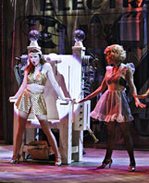HOME PAGE
SITE GUIDE
SEARCH
ADVERTISING AT CURTAINUP
REVIEWS
FEATURES
NEWS
Etcetera and
Short Term Listings
LISTINGS
Broadway
Off-Broadway
NYC Restaurants
BOOKS and CDs
OTHER PLACES
Berkshires
London
California
New Jersey
Philadelphia
Elsewhere
QUOTES
TKTS
PLAYWRIGHTS' ALBUMS
LETTERS TO EDITOR
FILM
LINKS
MISCELLANEOUS
Free Updates
Masthead
Writing for Us
A CurtainUp Los Angeles Review
Nightmare Alley
|
Why would I make myself a Victim, Unless I wanted my dreams to come true? — Stan |

A scene from Nightmare Alley
(Photo: Michael Lamont) |
Director Gil Cates has nursed it along for two years and the result, despite a slow first act, is gripping. Particularly memorable is James Barbour as Stan in a breathtaking performance that builds in power to the end. Barbour doesn't release his powerful voice too soon and has the pertinacity to begin on a whisper and end with a cry.
No expense has been spared in decking out The Geffen Playhouse with the garish trappings of a cheap sideshow traveling the Dust Bowl in 1932, courtesy of Set Designer John Arnone. Gerald Sternbach as the Conductor sits with his back to us at an organ. From there he conducts an invisible four-piece orchestra backstage. Mary Gordon Murray opens the show as Zeena with a quirky beguiling rendition of "Nightmare Alley - A Ten in One" which refers to ten acts under one tent for a single admission ticket. Zeena is a psychic but here she reminds us of the Emcee who opens the show in Cabaret.
From there we segue into a delightful soft shoe number with Zeena and introducing Pete (the versatile Larry Cedar who also plays the Sheriff and Mrs Peabody). Stan hangs around the carnival dying to get in and picking up what crumbs come his way, for instance, the Tarot Cards projected on stage left in which Pete sees a terrifying image of Death. Pete, a former mind-reader who gave it up when he predicted the death of a friend in the 1929 crash, is an alcoholic. The bottle he filches from Stan is his downfall and he literally haunts Stan with a sense of guilt. Pete's ghost appears to Stan from time to time.
Other characters include Clem, the gruff Carny boss (Michael McCarty, even more wonderful as the lecherous Ezra Grimble in Act Two) and Molly (Sarah Glendening), a pretty orphan of a gambler father who is down on her luck. She also sings, as demonstrated in the wistful "Lucky Heart." Lending support are the somewhat underused Tarot Ladies (Melody Butiu, Anise E. Ritchie, Leslie Stevens and Alet Taylor).
Stan, the son of a heavy-handed preacher, eventually joins the troupe. He sings Molly the lovely "I Surrender" and love is in the air.
Act Two is darker, more powerful and Barbour, in a part he was born to play, comes into his own. Unfortunately, he's turned the sideshow into a spiritualist scam and its all downhill from here. Mary Gordon Murray makes a second appearance as the aptly named Dr. Lilith Ritter, a less fun part than Zeena, and, between Lilith and the bottle, Stan's got trouble. I won't spoil the end except to say Geek is an unforgettable concept from that old Tyrone Power movie.
The play is an unsettling parallel between the Depression and today. It also draws an eerie paradigm between the ancient Tarot cards and today's desperate con men. The script develops Stan's character. Perhaps it's his father's influence that leads him to fake spiritulism. With bewildered anguish, his final line queries why we make mistakes. Brielle's ominous chords echo that disaster. "Nightmare Alley" and "I Surrender"> are the songs that will go home from the theatre with you.
Bravo to the Geffen for throwing fresh light on this dark American classic!
|
Nightmare Alley Book, Music and Lyrics: Jonathan Brielle, based on William Lindsay Gresham's novel Director: Gilbert Cates Cast: Stan (James Barbour). Pete/Sheriff/Addie Peabody (Larry Cedar), Molly (Sarah Glendening). Clem/Ezra Grimble (Michael McCarty). Zeena/Dr. Lilith Ritter (Mary Gordon Murray), Tarot Ladies (Melody Butiu, Anise E. Ritchie, Leslie Stevens, Alet Taylor), Roustabouts (Travis Leland, Burke Walton). Conductor/Keyboards: Gerald Sternbach Set Design: John Arnone Costume Design: Christina Haatainen Jones Lighting Design: Daniel Ionazzi Sound Design: Brian Hsieh Choreography: Kay Cole Orchestration: Irwin Fisch Musical Direction: Gerald Sternbach Production Stage Manager: Mary Michele Miner Running Time: Two hours, ten minutes Running Dates: April 21-May 23, 20210 Place: The Geffen Playhouse, 10886 Le Conte Avenue, Westwood Village, Los Angeles. Reservations: (310) 208-5454. Reviewed by Laura Hitchcock on April 21. |
|
Musical Numbers
| |
Act One
|
Act Two
|
|
Subscribe to our FREE email updates with a note from editor Elyse Sommer about additions to the website -- with main page hot links to the latest features posted at our numerous locations. To subscribe,
E-mail:
 esommer@curtainup.comesommer@curtainup.com esommer@curtainup.comesommer@curtainup.comput SUBSCRIBE CURTAINUP EMAIL UPDATE in the subject line and your full name and email address in the body of the message -- if you can spare a minute, tell us how you came to CurtainUp and from what part of the country. Visit Curtainup's Blog Annex Curtainup at Facebook . . . Curtainup at Twitter REVIEW FEEDBACK Highlight one of the responses below and click "copy" or"CTRL+C"
Paste the highlighted text into the subject line (CTRL+ V): Feel free to add detailed comments in the body of the email. . .also the names and emails of any friends to whom you'd like us to forward a copy of this review. |






